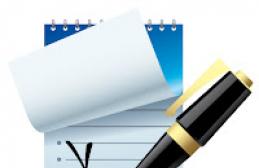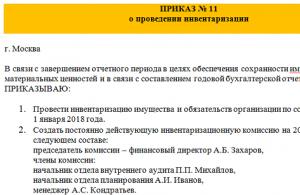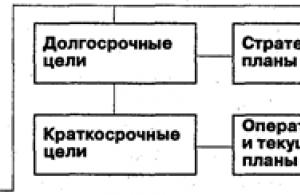In principle, questions about how and by what means can be created and sent should not arise. However, not everyone is ready to immediately begin this task when it comes to official letters, especially when the author of the letter expects to receive a response. I’ll tell you a little secret of business correspondence: the stricter the character and style of the letter, the greater the chance of a response from the recipient. In this lesson, I will provide several sample emails that should help users decide on their own style and subsequently compose messages in the most competent way.
First, we need to decide what nature the letter we are creating will be. I divide all outgoing emails into three main types:
- Business offer
- Business inquiry
- Friendly address
Accordingly, for all three types I have templates, both in the form of simple text files and in the form of templates tailored for specific email programs. Let's move on to each of them in order.
Business offer
Hello (Good afternoon), [name of the person being addressed]!
It is advisable to indicate the name in any letter when communicating, because a personal address puts a person in a friendly mood. However, if you still can’t find out the name, a template greeting will suffice.
Let me introduce to your attention a new service (new product) from our company [company name].
Let me offer cooperation in the field of [name of field of activity].
Next, briefly describe the advantages of your proposal in terms of price or some quality characteristics. The main thing is not to overdo it. Megabytes of text, and even supplemented with bright, meaningless pictures, only scare people away. If the recipient of the letter is interested in your offer from the first lines, he will definitely contact you for additional information.
If you're serious about getting the right people to contact you the first time you contact them, then it makes sense to think about reach beyond just email. It would be a good idea to create accounts in services such as ICQ andSkype. Sometimes it is much easier for a person to contact you by regular phone, if, of course, you thoughtfully left the number in your signature.
Why do you need to duplicate your own e-mail address in the signature, you ask, if it is automatically forwarded by the mail server. The rule here is that excessive information in business correspondence is never unnecessary. Let’s imagine a situation where your letter is received by a person who is potentially not interested in the offer, or who is simply not competent to respond to it correctly. It forwards the received message to another user, but for some reason, information about the true sender is lost from the automatically added data, which makes it difficult to contact you. However, it will always be enough to look at the signature to determine the author of the letter and his necessary contacts.
Business inquiry
Hello (Good afternoon)!
Or, if the addressee's name is known, then (Dear, [Name, Patronymic])!
Please provide information about the product (service) [name of product/service] with a description of the full characteristics and competitive qualities.
Based on the Federal Law of the Russian Federation [number and date of the document], I ask you to provide information [describe the data necessary to obtain].
You can also contact the management of a particular service on the Internet if your rights are violated.
In connection with the violation of clause [clause number in the user agreement] of the user agreement, namely: “[quote the full text of the said clause]”, I ask you to conduct an investigation and take appropriate sanctions against the guilty [responsible (if we are talking about service employees)] person [site (site name)]. Please report the results of the inspection and the sanctions imposed to [your own email address].
Friendly address
Greetings (Good day) (Hello), [person's name]!
When you first contact us in a friendly manner, a good indicator will be the completeness of your text message. A correctly written, voluminous text will indicate your high interest in contacting the right person and will arouse a desire for a response. Don't forget to open up the conversation with a few initial questions.
Example email
Email is used for exchanging electronic messages - sending an email takes place in a matter of minutes and is free.
What actions can you do in email?
In email you can read the received letter and answer it, send an email, and, in addition, other actions such as sorting mail, deleting letters that are not interesting to you.
How to write a new letter?
As a rule, in every email system, there is a button “compose a new letter” or “compose a letter”. By clicking on this button, a window (envelope) will open, where there will be several fields that must be filled in to send an email. As with regular envelopes, you firstly indicate the address to whom you are writing the letter. The second field or second part to fill out is the subject of the letter, where you briefly indicate what the letter is about. Writing a subject line is considered good form. The third part is the text of the letter itself. In this field you write your message that you want to send. You don't have to write your message, but simply attach a text file with your message to the letter. You can also attach video and photo files to the letter.
How to attach a file to an email?
In addition to a text message, when sending an email, you can also send some additional file, for example, photos. To do this, you need to click on the “attach file” button and select the file you want to send. After some time, the file will be downloaded, this can be seen by the presence of a bird next to the file, and you will be able to send a letter along with the file.
How to reply to an email?
To reply to an incoming email, gently click on the “reply” button. This is convenient, since the sender’s original text is preserved and you can always read the entire dialogue from the beginning. This is done so that the sender (or other parties to the dialogue) to whom you are responding can understand what was previously discussed.
It should be taken into account that when you click on the “reply” button, only the text of the received message and your letter itself are sent back, and all files attached by the sender are not sent.
Also, in the response letter, one Re will be added in the subject line each time. This means that the received letter is a response to a previously sent one (from the English “replay”). There's nothing wrong with that.
Over the past decades, business correspondence via email has gained immense popularity and has become one of the main methods of business communication. Today it is difficult to find a person who would not use e-mail in the practice of interpersonal communications. Despite this, many today are asking the question: so that all the rules are followed? How can you use a competent letter to form a good impression of the sender among the recipient?
This article describes the rules for business correspondence by email, and the practical tips presented in the article will help you learn proper business communication when composing emails.
Many people start their working day by checking their mailbox for new messages. But, unfortunately, despite the prevalence of this method of exchanging information, many do not know how to correctly use the language of business correspondence, mistaking emails for an informal way of communication.
Thanks to the speed of delivery, it simplifies the exchange of important official documents, forms, applications, but even here people make mistakes when sending letters. It very often happens that when composing an email when exchanging any files, recipients for some reason do not write accompanying essays and do not enter topics, which can complicate the work of recipients. The purpose of this article is to answer the question: how to send a letter by e-mail and comply with all the rules of business written communication via e-mail?
When composing emails, all fields provided must be filled in
The rules of business correspondence by e-mail oblige the sender of the letter to fill out all the fields provided in the e-mail, such as the address and name of the recipient and sender of the letter. A subject must be described that briefly describes the essence of the letter being sent. Very often, the fate of the sent letter and the speed of resolution of the problem stated in it depend on the correctly described topic. A business email should begin with a greeting - this simple show of respect for the recipient is very important when corresponding. After the greeting, there should be a text that is called the “body of the letter”, and at the end there should be a signature, for example, “With respect, Petr Ivanovich Brisov.”
Greetings in business correspondence
This point is worth further focusing on, since a gesture of respect is very important in any aspect of business communications. The optimal greeting phrase is “Good afternoon” or “Hello.” Conducting business correspondence via email limits the sender from using the phrases “Good evening” or “Good morning”, since the recipient may read the letter much later than receiving it. It is also not correct to use colloquial expressions used in greetings.
After a greeting word or phrase, you should address the recipient by name and patronymic, and if the name is unknown to the sender, this moment can be skipped. Then you can move on to stating the purpose of the letter.
Attached files in business emails
If the main purpose of the letter is not only a written narrative and presentation of the essence of the issue, but also sending a file, then it is better to attach the sent object first. It often happens that many senders, due to inattention, having stated the essence of the issue in the body of the letter, forget to attach the necessary attachment. Such negligence can negatively affect the business reputation of the sender of a business letter.

The email address should be recognizable and concise
The rules of business correspondence by e-mail require the sender to have a recognizable electronic name, which must contain truthful information about the name of the sender. Official letters and appeals look very unconcise and stupid when the email address contains informal expressions or words, for example, the email address “limon_petya”. This looks very undignified for an adult. To conduct business correspondence, it is better to create a separate email and observe business email etiquette.
Using the quick Reply (Response) function to respond to previously received emails
The Reply or Response function (in its abbreviated version it looks like Re:) helps the user to quickly respond to previously sent messages from the sender. This function also has the universal ability to read previous correspondence with an interlocutor on a given topic. But the rules of business correspondence by e-mail oblige the sender to rename the subject of the business letter if the essence of the discussion is changed during the correspondence.
Before sending a business letter, you should proofread for spelling errors and punctuation.
E-mail simplifies the exchange of information, but during business correspondence you should not neglect the rules of the Russian language, since a carelessly made mistake can affect the authority of the sender. Before sending a letter, you should review the text several times and carefully check it for spelling and punctuation errors. Many email clients have a spell check feature, so you should pay attention to the words underlined in red. If you have doubts about the correct spelling, you should seek help on the Internet or check the spelling using a spelling dictionary.

The addressee field should be filled in last
To avoid sending unfinished or unedited letters, the address of the recipient of a business letter should be entered at the very last moment before sending. This rule is also included in the basics of business email correspondence. It happens that when filling out the addressee field, email may offer a list of previously used recipients; here you should also focus your attention so as not to mistakenly send a composed business letter to a third-party addressee.
Structuring a business letter
The rules for structuring text apply not only to paper media, but also to the rules of business correspondence via e-mail. It is not always convenient for the recipient to read large volumes of text of letters on the monitor screen. To simplify this point, you should break the text into logically formed small paragraphs and avoid complicated sentences when writing the text of business letters. The optimal length of one sentence in a business letter should be no more than fifteen words.
The essence of a business letter should be stated in essence
In addition to the specified topic of the business letter, the recipient should also be interested in the clearly formulated first and second sentences of the main text. The sender’s task is to state at the beginning of the letter the essence of the problem or issue for which he is addressing the recipient. The first sentence should indicate the purpose for which the business letter is being sent. Sample: “We inform you that the terms of the obligation under contract No. 45 of 01/02/2017 “On the supply of bulk materials” are coming to an end. To renew the contract, you must submit a second package of documents.” Thanks to the designated purpose, the recipient has the opportunity to understand the main idea of the business letter. If the text of the letter is too large, then it is better to use the function of attaching an object as an attachment in the form of a text document, but at the same time, in the text field, you should leave the accompanying essay that highlights the business letter. Sample: “We are sending you an electronic copy of the letter from the company Mak-Stroy LLC for your review.” We ask you to inform us of your decision on the issue of extending contract No. 45 of 01/02/2017 “On the supply of bulk materials” until the deadline specified in the letter.”
Every business email should have a response.
There are negative examples of business correspondence when the recipient ignores the business letter for some reason. Sometimes there may indeed be cases when an answer cannot be given due to certain situations, for example, the resolution of the problem may take several days or the recipient is in thought and cannot immediately answer the question posed. In this case, a brief comment on this matter should be given, for example, “Hello, Pyotr Ivanovich. I received your letter, but today I find it difficult to respond, since I must consult with senior management. I will report your problem to the CEO of our company and give an official response by the end of the week. Sincerely, Sales Department Manager Belov Ivan Gennadievich.”

It is worth remembering that if a response was not given within three working days, then the fact that the recipient of a business letter remains silent can be assessed as ignoring and refusing to communicate with the sender.
When writing response letters, you should answer all the questions asked.
If the letter sent to the recipient is of an interrogative nature, then when composing the letter you should give answers to the questions in the order that is present in the received text of the business letter. If questions have been asked, the sender hopes to receive specific answers to them. When composing a letter, you should not number your answers; you just need to state your thoughts in order. In order to answer all the questions posed, you first need to re-read the received business letter several times, and if there are too many questions, it is better to write them out separately to prevent them from being missed. If it is impossible to answer some of the questions posed, it is worth pointing out that at the moment for some reason the answer cannot be given.

Do not overuse abbreviations, emotional design and capital letters
There are negative examples of business correspondence when senders dilute it by using informal signs in the form of emoticons. Their use is popular when communicating on social networks, however, the rules of business correspondence do not welcome such manifestations of emotions, since the recipient may not know their true meaning and take them for an incomprehensible set of punctuation errors.

You should also stop writing text in capital letters. On the Internet, a set of words written in capital letters is called “flashy phrases” and more often than not such phrases carry a negative connotation. The recipient, when reading an electronic business letter, may evaluate such a font negatively, which will have a detrimental effect on the perception of meaning. If in a business letter you need to emphasize the importance of any point, it is better to use introductory phrases, for example, “Please note that you need to provide a package of documents to renew the contract no later than 02/10/2017” or “Please note that the documents the contract extension must be submitted by 02/10/2017.”
Do not transmit sensitive information via email
When transmitting personal or confidential information, it is better to refuse electronic mailboxes, as there is a threat of information being intercepted by attackers for use for their own selfish purposes. Such information may include: telephone numbers, passwords for bank cards, personal bank accounts, etc. It is important to remember that the information is stored on the mail agent server and can be stolen if hacked.
The sender's signature must be at the end of the letter.
As mentioned earlier, every letter sent must contain a specific signature. Often, mailbox developers introduce a signature block function, in which you can enter your job title, name and contact phone number. Subsequently, this block will automatically appear at the end of each letter, which will make typing easier. It is important to write a signature correctly so that the recipient has the opportunity to correctly address the sender when replying to the letter. An example of a signature might look like this: “With respect, Nikolai Alexandrovich Petrov, +79810000000.”

Drawing conclusions, it can be noted that in order to understand how to conduct business correspondence by email, you do not need to master additional and complex basics. You just have to adhere to the basic rules of etiquette and observe the norms of the Russian language.
Today we will talk about quoting letters. What is it and why do you need it? It's simple. When you communicate with an interlocutor, it is much easier to communicate if you see in the letter your previous correspondence with him. At the same time, it is easier to remember what you previously corresponded about and what issues were raised in past letters. Again, in order not to repeat ourselves and forget what we corresponded about.
I’ll tell you using the example of responding to letters in Yandex mail, as well as responding to letters in the “The Bat!” email client. Here are instructions on how to...
In Yandex mail:
1.So, We open the letter we want to respond to.
4. This is the letter the addressee will receive.
In the mail client "TheBat!”:
In a programme « TheBat!” you can also quote letters.
And this is not much more difficult to do than in the above example.
First, open the email client program itself.
Select the desired mailbox.
Let's click on it.
Now select the desired letter from the inbox.
1. Opening the letter, which we want to answer by clicking on it with the mouse.
2. This is what the letter itself looks like.
3. Click on the image of the envelope with the green arrow pointing to the left(fourth from the left!) to respond to the letter.
4. As a result, we open a new letter with the text of your interlocutor. Previous messages, as in the previous example, are highlighted with check marks.
5. We write our answer and send it to the recipient by clicking the “Send immediately” button, in the form of an envelope and a green arrow at the top (located very first on the left).
6. This is the letter the addressee will receive.
That's all. Sometimes it’s nice, and sometimes useful, to quote previous correspondence...
When we write a letter to a friend or relative, we can ignore mistakes and punctuation marks, abbreviate words as we like, and use slang. The main thing is to make it clear what we are talking about. But if we write to a stranger or an unfamiliar person and want to get an answer from him, then we should take into account some rules.
Rules of communication
1 . Always indicate the subject of the letter.
The “Subject” field must be filled in in any case and it is highly desirable that it corresponds to the content of the message.
For example, if you want to make an appointment for a consultation on March 5th, write: “Sign up for a consultation (03/05).”
2. When replying to a letter, save your correspondence history.
When you receive a letter from someone, you can respond to it in three ways:
- Copy the sender's address and write him a new letter.
- Click on the special reply field at the bottom of the message.
- Use the "Reply" button.
For business correspondence, you should respond in the third way, that is, click on the “Reply” button. A new email will open, repeating the one you received. The topic is the same, only with the prefix “Re:”, the original text is fully quoted.
This is the standard response form and you should not change anything about it. Your answer must be printed before the quoted text. This is done so that each participant in the conversation can remember what was discussed at any time.

3. Always say hello and address your interlocutor as "you".
Any message should begin with a greeting. And it is better if it is individual. If appropriate, call the interlocutor by name, otherwise - by first name and patronymic.
It is advisable to end the letter with the following construction: Sincerely, ... (first name/surname or first name/patronymic).
For example: Hello, Alexey Petrovich. Please send the contract to Ivan Mikhailovich. Best regards, Ilya Krivosheev
4 . Reply as quickly as possible.
The sooner you respond to a message, the better. Ideally within a few hours. But it is also possible within a few days. The longer you wait to respond, the worse it affects your reputation.
As for the text of the message, when writing it you should also follow some rules.
Write specifically, but in detail
Don't make the other person guess what you meant. If the problem is not obvious, describe it in as much detail as possible: how you got the result you have, what exactly you want to achieve and what is required from your interlocutor.
But this does not mean that you need to indicate all the details in great detail. Skip the unnecessary stuff - value the other person’s time.
Try to write briefly and to the point
There is no need, for example, to talk about how your wife, mother-in-law and other relatives are doing.
As for size, ideally one “screen” (no scrolling). Maximum - text size that fits on an A4 sheet.
Use common sense and common decency
Be polite, attentive, thank you for your letters and time.
What you absolutely CAN NOT do
1 . Abuse punctuation marks.
One exclamation or question mark is enough. They should not be duplicated. Also, do not overuse ellipses.
An example of a “bad” letter:

2. Use different fonts, letter sizes and colors.
Mail sites and programs allow you to change these settings. You can choose an unusual font, make the letters larger or smaller, or color the text in different colors. But this is inappropriate in business correspondence!
It’s better not to change anything at all and leave everything as it is by default. The only thing that is acceptable is to highlight some words in bold or italics. But only if necessary!
An example of a “bad” letter:

3. Insert smiley pictures.
Leave happy and sad faces, flowers and hearts for personal correspondence. In business letters, it is better not to use emoticons - neither text nor pictures.
An example of a “bad” letter:

4 . Print text in capital letters.
Typing text in capital letters on the Internet is considered bad manners. This applies to both business and personal correspondence, as well as communication on social networks, Skype, forums and other places. Moreover, this applies to both the entire text and individual words.
The Caps Lock keyboard key is responsible for capital letters. That is, if all your letters are typed in capitals, you just need to press it once and release.

Moreover, do not print the “Subject” of the letter in capital letters - this is the height of disrespect!
On a note . Typing individual words and entire text in capital letters feels like shouting. And screaming is aggression, which goes beyond cultural correspondence.
If you really need to highlight something in the text, it is better to do it using bold or italics.
And it is also very advisable to avoid the words “Urgent”, “Important” and others that express impatience in the subject line of the letter.
Literacy
You should not be too strict about this, but try to write correctly in your letters. A few simple tips:
- Every sentence must begin with a capital letter. To type it, hold down the Shift key.
- There must be a period at the end of every sentence. In the Russian keyboard layout, it is located in the bottom row on the right (before Shift).
- To type a comma, hold Shift and press the period key.
- Do not put a space before a comma or period. There should be a space after them.
And one more piece of advice for those who know at least a little how to use the Word text editor (Writer). First type the letter in this program. It will highlight errors with a red line and by right-clicking on such a word, you can correct it.

Copy and paste the finished text into the letter field. But before inserting, you should disable formatting so that it can be added without formatting from Word (Writer).
In mail.ru mail, to do this, you need to click on the “Remove design” at the top.

In Yandex.Mail - the “Disable design” button on the right.
After pasting, the appearance can be turned back on.
















